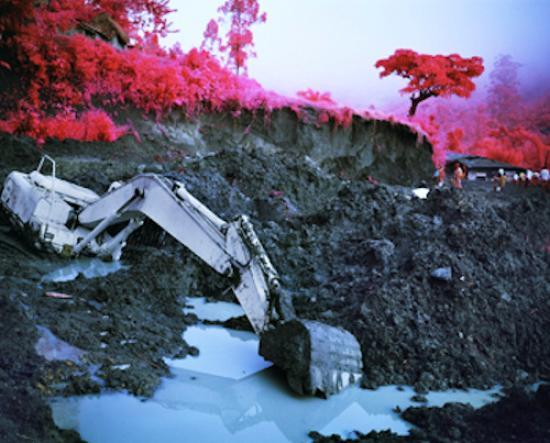Unstable Territory. Borders and Identity in Contemporary Art
27th October 2013

11 October 2013–19 January 2014.
Centre for Contemporary Culture Strozzina
Fondazione Palazzo Strozzi
Palazzo Strozzi, Florence
Hours: Tuesday–Sunday 10am–8pm;
Free Thursdays 6–11pm.
www.strozzina.org
The CCC Strozzina, part of the Fondazione Palazzo Strozzi, is devoted to producing and presenting thematic exhibitions, following an interdisciplinary approach to current trends in contemporary culture, and fulfilling the mission to establish a lively and engaging centre for contemporary art in the heart of Florence.
This exhibition, curated by Walter Guadagnini (freelance curator) and Franziska Nori (CCC Strozzina Director), showcases work by ten international artists (Kader Attia, Zanny Begg & Oliver Ressler, Adam Broomberg & Oliver Chanarin, Paolo Cirio, Tadashi Kawamata, Sigalit Landau, Richard Mosse, Paulo Nazareth, Jo Ractliffe, The Cool Couple) that encourages visitors to reconsider the notion of territory, borders and boundaries whose instability becomes crucial to the definition of individual and collective identity, as theorised by the sociologist Ulrich Beck—whose contribution is featured in the exhibition catalogue. Photographs, videos and installations spark reflections on the idea of the border as discovery or barrier, on the hybridisation between cosmopolitanism and territoriality, on the figure of the artist himself as traveller or experimenter between physical and symbolic territories.
Tadashi Kawamata has produced three site-specific installations: on the façade and in the courtyard of Palazzo Strozzi, and inside the CCC Strozzina. Intensifying his reflection on the confrontation of ephemeral constructions when juxtaposed with monumental architecture, Kawamata reacts to the Palazzo's powerful Renaissance structure, creating a strong contrast between transitory materials and permanent, historical architecture.
Artists Paulo Nazareth and Sigalit Landau focus their research on their own body and its relationship to territories and boundaries. Landau reflects on the theme of physical and symbolic boundaries and on the juxtaposition between life and death, the achievement and loss of identity. The heterogeneous work of Nazareth discloses a reflection on his figure as a nomadic artist playing with his multi-ethnic identity through performances and encounters with different people and places.
Addressing a topical theme for Italy, the exhibition also presents Zanny Begg and Oliver Ressler tackling the issue of citizenship rights and national identity, dwelling on the main legal tool for travel and residency: the passport. Kader Attia explores instead the contradictions in the notion of the re-appropriation of culture and identity. For this exhibition he presents a series of works that encourage visitors to reflect on external space and identity, physical and psychological territories.
Richard Mosse presents his six-channel video installation The Enclave, recently featured at the Irish Pavilion in the 2013 Venice Biennale. In a striking atmosphere, Mosse engages visitors in an emotional experience to explore landscapes of eastern Congo, marked by an extraordinary and almost alienating beauty, where the twenty-year civil war has killed over five million people.
Exposing the inconsistencies of the financial globalisation, Paolo Cirio presents the project Loophole for All merging digital hacking with artistic action. Playing on tax "loopholes" in Cayman Islands law, Cirio has created an online platform that makes tax evasion legal and possible for all, not only for famous hedge funds and multinational corporations.
The works by Adam Broomberg and Oliver Chanarin, The Cool Couple and Jo Ractliffe lie in the furrow of a reflection on the status of photography as a record of contradictory territories. The first artists present a new stage of their Chicago project, a video and photographic installation of a non-place, a territory both real and unreal. The Italian duo presents instead a new production focusing on a border area, the Carnia region in Friuli-Venezia Giulia, and on a historical event known to few and forgotten by most, namely the enforced presence of the Cossack community in the area in 1944. In the series As Terras do Fim do Mundo, Ractliffe, on the other hand, proposes a poetic survey of the places that were the theatre of the bloody civil war in Angola in the seventies.
PHOTO
Richard Mosse, "Stalemate," 2011. Digital c-print. Courtesy the artist
and Jack Shainman Gallery, New York.



